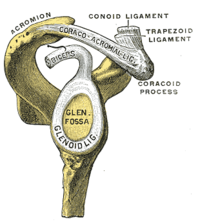
Photo from wikipedia
Objectives: The initial clinical presentation of the discoid lateral meniscus (DLM) in children is highly variable and can be difficult to assess. The aim of this study was to focus… Click to show full abstract
Objectives: The initial clinical presentation of the discoid lateral meniscus (DLM) in children is highly variable and can be difficult to assess. The aim of this study was to focus on the meniscal instability associated with DLM and to correlate clinical, MRI and arthroscopic data. Methods: Between 2008 and 2018, 93 children and adolescents with 114 DLMs who underwent surgery in a referral center were included. Based on the anamnesis and clinical data, three types of meniscal instability of increasing severity were defined: occasional ("lock"), regular ("clock") and permanent ("block") instability. These findings were correlated with preoperative MRI data and arthroscopic findings according to Ahn’s classification, and as a result we were able to propose a DLM classification based on clinical or MRI data or both combined. Results: A wide variety of presentations was noted with 18 different types when clinical, MRI and arthroscopic characteristics were combined. 94% of the symptomatic DLMs for which surgery was performed showed instability due to meniscocapsular separation. Clinically, there were "lock", "clock" and "block" instability in 2%, 50% and 31% of DLMs respectively. Preoperative MRI indicated no meniscal shift and an anterocentral, posterocentral or central shift in 41%, 9%, 22% and 28% of the DLMs, respectively. Arthroscopic findings indicated no lesions, or an MC-A, MC-P or PLC type lesion in 6%, 46%, 15% and 33% of DLMs respectively. The most frequent presentations were “clocked” knees with MC-A lesions and “blocked” knees with PLC lesions. Only in 60% of the cases was a good level of correspondence noted between the different data. Conclusion: The association of meniscal instability and symptomatic DLM in children should be accepted as a certainty. “Locked”, “clocked” and “blocked” knees could represent different stages of increasing severity in the natural history of DLM instability.
Journal Title: Orthopaedic Journal of Sports Medicine
Year Published: 2021
Link to full text (if available)
Share on Social Media: Sign Up to like & get
recommendations!